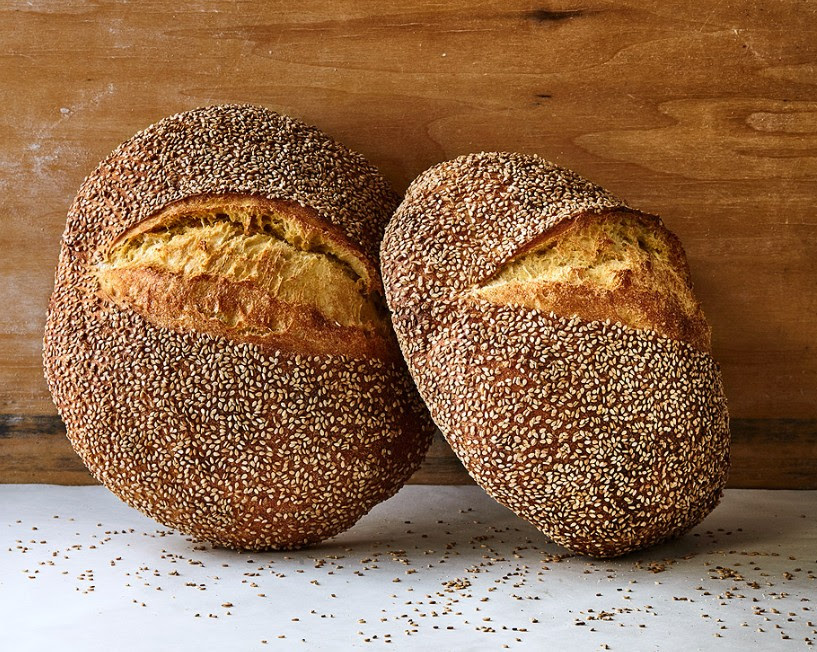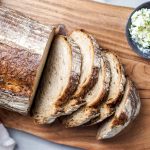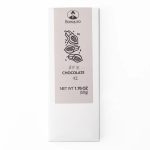Excerpt from Ari’s Top 5 enews
A longtime Sicilian classic that’s now better than ever!
 To be clear, the Sesame Semolina has always been excellent. I agree with Bakehouse managing partner Amy Emberling who said, “I really enjoy that bread—to eat and just to look at. The color of the crumb is so beautiful!” I’m happy to say that the Semolina loaves that have been so good for so long are now, thanks to the fresh on-site milling of the grain, even better still. This move to begin milling the semolina here at the Bakehouse is right in line with Natural Law #8: “To get to greatness you’ve got to keep getting better, all the time!”
To be clear, the Sesame Semolina has always been excellent. I agree with Bakehouse managing partner Amy Emberling who said, “I really enjoy that bread—to eat and just to look at. The color of the crumb is so beautiful!” I’m happy to say that the Semolina loaves that have been so good for so long are now, thanks to the fresh on-site milling of the grain, even better still. This move to begin milling the semolina here at the Bakehouse is right in line with Natural Law #8: “To get to greatness you’ve got to keep getting better, all the time!”
As we long ago learned through our focus on traditional cooking and baking, getting better at Zingerman’s very often means looking first to the past. Rebecca Solnit writes about “people looking backward and passing something forward.” Three hundred years ago, baking with freshly milled flour would have been unremarkable. “Thanks” to the Industrial Revolution, today it’s an anomaly. Once upon a time, though, there were local mills in nearly every town. When Europeans came to the Americas to conquer and colonize, they brought wheat with them, and soon after their arrival began to grow it here. Milling quickly became an essential part of community existence. At the time, mills were powered primarily by wind and steam. In the early 19th century, a number of mechanical improvements began to be made to milling. Railroads made it easier to ship flour and made communities less dependent on local mills. By 1900 the number of local mills was already decreasing. By the time we opened the Deli in 1982, local mills were few and far between!
We’ve gradually added more items to the “milled right here” list—at this point most of our breads and many of our pastries now benefit from the full flavor of freshly milled grain. The Semolina bread is the latest bread to benefit. Hazim Tugun, who’s helped lead this fresh milling project from the get-go, says:
It’s a perfect example of how we can take an already great food to the next level. And it shows how freshly milled whole grain flours can do that. In this case, our current Sesame Semolina is mostly made of durum wheat flour that comes from the heart (or the starchy endosperm) of the golden durum wheat berry, hence the bread’s golden color—it is a combination of coarsely milled semolina and finely milled durum flours. With an overnight preferment (poolish) and a long fermentation the day that the dough is mixed coupled with toasted sesame seeds on the outside, you get an irresistible bread that gives you the distinct flavors of the durum wheat, the chew from the hardness of this wheat (after all, it is the wheat of choice for pasta), and it’s a wonderful combination with the toasted sesame seeds.
For the new Sesame Semolina, we are stone-milling Montana-grown organic durum wheat that we are getting from our friends at Janie’s Mill and using this finely milled fresh flour to replace one third of all the flour that goes into the bread. That means we are getting the wonderful flavor and nutrition benefits of the bran and the germ as well—aromatic oils, minerals, and fiber to name a few. On the inside, this new version has a slightly more moist and relatively softer crumb with a richer hue of yellow thanks to the addition of the fresh durum flour. Now, you can simply taste and smell more of the grain that this bread is named after … it’s sweeter, a bit nuttier, and to me, more satisfying.
James MacGuire, writing in The Art of Eating, says, “The best bread comes from serious consideration of every detail.” (You’ll need a subscription but it’s good to support small journalism publications, which we might consider as the writing equivalent of local milling). Kudos to everyone at the Bakehouse for making what McGuire has called out a meaningful everyday reality. I feel fortunate to be able to eat such great bread every day!




